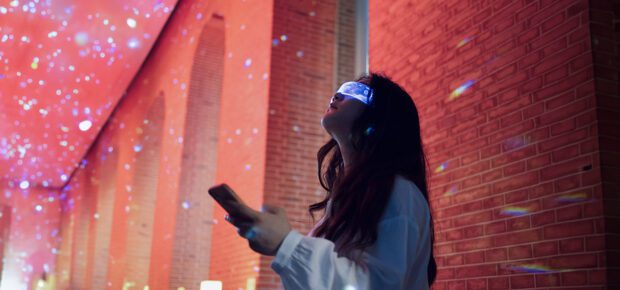December 14, 2023
You may not have noticed, but a major change may be afoot in the world of Wi-Fi. In late-2023, U.S. telecommunications regulators opened the 6 GHz band for ultra-low power use. The move could make wearables lighter and faster, and facilitate a better experience in smart home devices. The big winner, however, is extended reality, or XR, an umbrella term for technologies like virtual reality and augmented reality.
Why is 6 GHz Important?
There are a lot of devices out there, and when they use Wi-Fi, they generally use one of two spectrum bands, either 2.4 GHz or 5 GHz. But those spectrum bands are getting crowded.
More spectrum equals more capacity. To alleviate network congestion, the FCC first opened the 6 GHz band to Wi-Fi in 2020 under certain conditions. A detailed discussion of that decision was covered by the IEEE Communications Society blog.
That move greatly expanded the available spectrum for Wi-Fi, which is significant for technology companies looking to develop faster, more reliable wireless services, said IEEE Senior member David Witkowski.
“It will alleviate Wi-Fi channel crowding in urban areas, and will allow wireless ISPs to build higher-performance data networks with wider channels and less interference.
“One of the significant challenges in 5 GHz is that portions of the band are prioritized for weather radar use, so the number of usable channels is much lower than the number of allocated channels,” Witkowski said.
The 2.4 GHz band, meanwhile, is subject to interference from microwaves and cordless phones.
What are the Interference Challenges with 6 GHz?
One problem with opening the 6 GHz spectrum band is that other services were already using it, raising concerns over interference.
This band has been traditionally used for services like fixed satellite service and for microwave services such as wireless backhaul, utilities and public safety applications also relied on it.
So when the FCC originally allowed devices to access the 6 GHz band, it did so with some caveats. Low power devices (which are different from the very low power devices) could be used indoors under the assumption that a building’s walls would prevent interference. A second set of devices that did run the risk of interference need to get permission from a national database that knows the location of existing, licensed users.
The latest move involving very low power devices is seen as running less of a risk of interference because, even if the devices are used outdoors, the signal will not travel more than a few meters because of the low amounts of power involved. To get a more detailed look at the intricacies of that decision, check out this article from IEEE Spectrum.
Why is XR the Big Winner?
Most XR headsets need to be connected to the internet. Most use Wi-Fi to connect to the local router, and they work better when they have a strong Wi-Fi connection. However, turning data into images, known as processing or rendering, is fairly computationally intense. It needs powerful processors and lots of battery power.
“An alternative would be for headsets to stream video from a nearby computer which would do all the rendering,” said IEEE Fellow William Webb, a former director at Ofcom, the UK’s telecommunications regulator. “This reduces headset power consumption but requires wireless connectivity to the nearby computer, and the connectivity needs a high bandwidth. Low-power 6 GHz regulation is ideal for this. It only works over a few meters, but it can deliver high-bandwidth connectivity.
“Hence, it could result in lighter and cheaper XR headsets. These might then be able to last a full day on one battery charge.”
How Is the 6 GHz Spectrum Viewed Around the World?
Regulators across the planet have approached the issue of the 6 GHz spectrum band from different perspectives.
“Most countries have allowed the bottom half of the 6 GHz band to be used for Wi-Fi but are still debating whether the top half should be Wi-Fi or cellular,” Webb said. “Key is whether the upper 6 GHz band will be used for cellular in some countries which prevents its use for Wi-Fi (although I have shown that cellular and Wi-Fi could share well). The band is also used in some countries by other applications, which may prevent Wi-Fi being used close by, but this is fairly minor.”
These regulatory challenges do have implications for consumer products.
“Different global regions have varying regulations regarding the use of the 6 GHz band, which can pose challenges for global technology companies in terms of compliance and product design,” Witkowski said. “If 6 GHz is not adopted by all or most regulatory agencies, equipment vendors will not be able to leverage economies of scale to bring down costs.”





 Meaningful Momentum or Running in Place?
Meaningful Momentum or Running in Place? AI Through Our Ages
AI Through Our Ages Liquid Infrastructure: Our Planet's Most Precious Resource
Liquid Infrastructure: Our Planet's Most Precious Resource The Impact of Technology in 2025
The Impact of Technology in 2025 Quantum and AI: Safeguards or Threats to Cybersecurity?
Quantum and AI: Safeguards or Threats to Cybersecurity? Why AI Can't Live Without Us
Why AI Can't Live Without Us Bits, Bytes, Buildings and Bridges: Digital-Driven Infrastructure
Bits, Bytes, Buildings and Bridges: Digital-Driven Infrastructure Impact of Technology in 2024
Impact of Technology in 2024 Emerging AI Cybersecurity Challenges and Solutions
Emerging AI Cybersecurity Challenges and Solutions The Skies are Unlimited
The Skies are Unlimited Smart Cities 2030: How Tech is Reshaping Urbanscapes
Smart Cities 2030: How Tech is Reshaping Urbanscapes Impact of Technology 2023
Impact of Technology 2023 Cybersecurity for Life-Changing Innovations
Cybersecurity for Life-Changing Innovations Smarter Wearables Healthier Life
Smarter Wearables Healthier Life Infrastructure In Motion
Infrastructure In Motion The Impact of Tech in 2022 and Beyond
The Impact of Tech in 2022 and Beyond Cybersecurity, Technology and Protecting Our World
Cybersecurity, Technology and Protecting Our World How Technology Helps us Understand Our Health and Wellness
How Technology Helps us Understand Our Health and Wellness The Resilience of Humanity
The Resilience of Humanity Harnessing and Sustaining our Natural Resources
Harnessing and Sustaining our Natural Resources Creating Healthy Spaces Through Technology
Creating Healthy Spaces Through Technology Exceptional Infrastructure Challenges, Technology and Humanity
Exceptional Infrastructure Challenges, Technology and Humanity The Global Impact of IEEE's 802 Standards
The Global Impact of IEEE's 802 Standards Scenes of our Cyber Lives: The Security Threats and Technology Solutions Protecting Us
Scenes of our Cyber Lives: The Security Threats and Technology Solutions Protecting Us How Millennial Parents are Embracing Health and Wellness Technologies for Their Generation Alpha Kids
How Millennial Parents are Embracing Health and Wellness Technologies for Their Generation Alpha Kids Space Exploration, Technology and Our Lives
Space Exploration, Technology and Our Lives Global Innovation and the Environment
Global Innovation and the Environment How Technology, Privacy and Security are Changing Each Other (And Us)
How Technology, Privacy and Security are Changing Each Other (And Us) Find us in booth 31506, LVCC South Hall 3 and experience the Technology Moon Walk
Find us in booth 31506, LVCC South Hall 3 and experience the Technology Moon Walk Virtual and Mixed Reality
Virtual and Mixed Reality How Robots are Improving our Health
How Robots are Improving our Health IEEE Experts and the Robots They are Teaching
IEEE Experts and the Robots They are Teaching See how millennial parents around the world see AI impacting the lives of their tech-infused offspring
See how millennial parents around the world see AI impacting the lives of their tech-infused offspring Take the journey from farm to table and learn how IoT will help us reach the rising demand for food production
Take the journey from farm to table and learn how IoT will help us reach the rising demand for food production Watch technical experts discuss the latest cyber threats
Watch technical experts discuss the latest cyber threats Explore how researchers, teachers, explorers, healthcare and medical professionals use immersive technologies
Explore how researchers, teachers, explorers, healthcare and medical professionals use immersive technologies Follow the timeline to see how Generation AI will be impacted by technology
Follow the timeline to see how Generation AI will be impacted by technology Learn how your IoT data can be used by experiencing a day in a connected life
Learn how your IoT data can be used by experiencing a day in a connected life Listen to technical experts discuss the biggest security threats today
Listen to technical experts discuss the biggest security threats today See how tech has influenced and evolved with the Games
See how tech has influenced and evolved with the Games Enter our virtual home to explore the IoT (Internet of Things) technologies
Enter our virtual home to explore the IoT (Internet of Things) technologies Explore an interactive map showcasing exciting innovations in robotics
Explore an interactive map showcasing exciting innovations in robotics Interactively explore A.I. in recent Hollywood movies
Interactively explore A.I. in recent Hollywood movies Get immersed in technologies that will improve patients' lives
Get immersed in technologies that will improve patients' lives